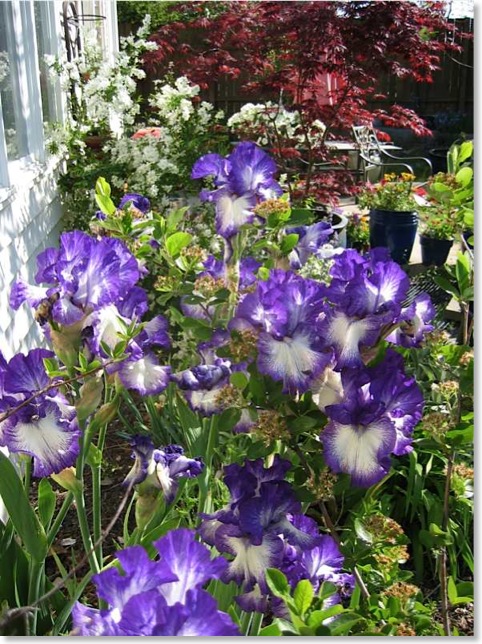A Pearl of a Bush
15/Mar/2008 21:28 Filed in: Garden Blog

One of the many nice things about gardeners is that they typically don't mind sharing their gardening secrets and successes. They're all too happy to see someone else enjoy gardening as much as they do. In fact, if you like gardening, be sure to make friends with some of the experts in your area and you'll likely soon find yourself receiving free cuttings, bulbs, and divisions of this or that flower. Most gardeners, particularly those with collections of perennial flowers, are continually challenged to thin out their stock and make room for more flowers.
When fully developed, one of the practical objectives of the new WSU Arboretum and Botanical Gardens will be to test and display horticultural varieties of landscaping and ornamental plants that are well suited to the unique Palouse Prairie climate of eastern Washington, which has a climatic pendulum that swings back and forth between cold, wet winters, and hot, extremely dry summers.
Given that I've benefited from the advice of so many wonderful authors and books on gardening (and more than my fair share of trial and error!), I feel compelled to share some recommendations on trees, shrubs, and flowers that have worked well for me in our gardens. Shrubs are almost a necessary part of any garden landscaping scheme. They provide a visual foundation for the garden and carry it through seasons when you are waiting for flowers to take over the show.
I'm definitely not an expert on shrubs, but I've accidentally stumbled across one old-fashioned shrub that puts on a dependable and spectacular flower display every year. The Pearl bush (Exochorda racemosa) seems to be considered by many gardening experts as an old-fashioned classic, which kind of surprises me. Until my wife and I saw one getting ready to bloom and picked one up at a local nursery, I'd never heard of it before. But it's quickly become a spectacular spring center piece next to our patio.

Unfortunately, I'll have to wait a few weeks to show you one of the most unique and beautiful features of this shrub, which you might guess from its name. Before blooming in spring, the branches are covered with rows of pure white flower buds that look just like pearls. These blossoms open into flowers that are bright white and reminiscent of large apple flower blossoms, but more translucent and delicate in appearance.

About the Pearl Bush
The Pearl bush is native to China, but well adapted to many garden situations here in eastern Washington. It reportedly grows 10-15 feet tall and wide, but my specimen is perhaps 4 1/2 feet tall and my wife tells me its about 6 years old. [Note: Some gardeners take detailed gardening notes every year, but I find it easier just to ask my wife.] Horticultural descriptions claim that Pearl bushes like well-drained acidic soil, but I've only got one of those two factors, very dry soil, and it's doing just fine. We definitely do not have acidic soils in our yard, but it doesn't seem to matter for this shrub.
We've got our Pearl bush planted up next to the house underneath our living room window, which is facing east to south east, so it gets early morning sun and then afternoon shade, which I find that many plants like in our hot summer climate. It's undoubtedly planted far too close to the house, being in the harsh dry zone next to the foundation, but it's beside our patio so it is easy to give it a bit of water once and a while during the heat of summer.

As you hopefully can see from the above photo, the pure white of a flowering Pearl bush makes a nice companion to many other flowers, such as the iris shown here blooming at the same time. However, I find that published horticultural descriptions are quite accurate about one aspect of this shrub - it sort of disappears after flowering.
By that I mean that after flowering, the bluish-green foliage blends into the background again and the shrub no longer stands out as a specimen. Overall, the shrub has an open, rambling, vaguely arching branching structure. Consequently, my specimen at least has an informal look about it. So don't expect it to stand out as a specimen shrub in the garden after flowering. It is better used as a magnificent seasonal display next to some other flowers that take over duties during the summer.
I probably shouldn't have shared this gardening secret or recommendation with you, because I'd actually like to pick up another Pearl bush and try it in a second location in our yard, maybe some place where it could grow substantially larger than the spot under our window, where it will soon need to be pruned. However, I've seldom seen Pearl bushes in local nurseries. In fact, I think its only been once or twice that I've noticed these shrubs in a nursery over the last 5-6 years.
So if you see one, better grab it quickly. And if its not in bloom when you buy it and you think it looks unremarkable, trust me and get it anyway. It'll be well worth finding a nice spot to put one in your flower garden. But if you think of it, please leave one in the nursery for me to buy. I definitely want another one.
R. Sayler